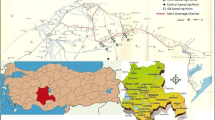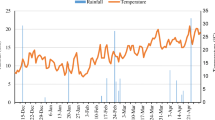Abstract
The objective of this 2-year field study was to evaluate the effects of drip irrigation with urban wastewaters reclaimed using primary (filtration) and secondary (filtration and aeration) processes on red cabbage growth and fresh yield, heavy metal content, water use and efficiency and soil chemical properties. Filtered wastewater (WW1), filtered and aerated wastewater (WW2), freshwater and filtered wastewater mix (1:1 by volume) (WW3) and freshwater (FW) were investigated as irrigation water treatments. Crop evapotranspiration decreased significantly, while water use efficiency increased under wastewater treatments compared to FW. WW1 treatment had the lowest value (474.2 mm), while FW treatments had the highest value (556.7 mm). The highest water use efficiency was found in the WW1 treatment as 8.41 kg m−3, and there was a twofold increase with regard to the FW. Wastewater irrigation increased soil fertility and therefore red cabbage yield. WW2 treatment produced the highest total fresh yield (40.02 Mg ha−1). However, wastewater irrigation increased the heavy metal content in crops and soil. Cd content in red cabbage heads was above the safe limit, and WW1 treatment had the highest value (0.168 mg kg−1). WW3 treatment among wastewater treatments is less risky in terms of soil and crop heavy metal pollution and faecal coliform contamination. Therefore, WW3 wastewater irrigation for red cabbage could be recommended for higher yield and water efficiency with regard to freshwater irrigation.




Similar content being viewed by others
References
Acar B, Paksoy M (2006) Effect of different irrigation methods on red cabbage (Brassica oleraceae L. var. capitata Subvar. F. rubra) yield and some plant characteristics. Pak J Biol Sci 9:2531–2534
Akan JC, Kolo BG, Yikala BS, Ogugbuaja VO (2013) Determination of some heavy metals in vegetable samples from Biu local government area, Borno State, North Eastern Nigeria. Int J Environ Monit Anal 1:40–46
Al-Karaki GN (2011) Utilization of treated sewage wastewater for green forage production in a hydroponic system. Emir J Food Agric 23:80–94
AOAC (1995) Official methods of analysis of AOAC International, 16th edn. Association of Official Analytical Chemists, Arlington
APHA (1995) Standard methods for the examination of water and wastewater. In: Eaton AD, Clesceri LS, Greenberg AE (eds), 19th ed. American Public Health Association, Washington, DC
Areola O, Dikinya O, Mosime L (2011) Comparative effects of secondary treated waste water irrigation on soil quality parameters under different crop types. Afr J Plant Sci Biotechnol 5:41–55
Ayers RS, Westcot DW (1985) Water quality for agriculture. FAO Irrigation and Drainage Paper 29, Rome
Balkhair KS, El-Nakhlawi FS, Ismail SM, Al-Solimani SG (2013) Treated wastewater use and its effect on water conservation, vegetative yield, yield components and water use efficiency of some vegetable crops grown under two different irrigation systems in western region, Saudi Arabia. Proceedings of 1st Annual International Interdisciplinary Conference, Azores, Portugal, pp 396-402
Chandorkar S, Deota P (2013) Heavy metal content of foods and health risk assessment in the study population of Vadodara. Curr World Environ 8:291–297
Chen X, Wang J, Shi Y, Zhao MQ, Chi GY (2011) Effects of cadmium on growth and photosynthetic activities in pakchoi and mustard. Bot Stud 52:41–46
Codex Alimentarius Commission (2001) Food additives and contaminants. Joint FAO/WHO Food Standards Programme, ALINORM 01/12A:1-289
Codex Alimentarius Commission (2011) Joint FAO/WHO food standards programme, codex committee on contaminants in foods, working document for information and use in discussions related to contaminants and toxins in the GSCTFF, CF/5 INF/1
Corcoran E, Nellemann C, Baker E, Bos R, Osborn D, Savelli H (2010) Sick water? The central role of wastewater management in sustainable development. A Rapid Response Assessment. United Nations Environment Programme, UN-HABITAT, GRID-Arendal, Norway
de Silva NDG, Cholewa E, Ryser P (2012) Effects of combined drought and heavy metal stresses on xylem structure and hydraulic conductivity in red maple (Acer rubrum L.). J Exp Bot 63:5957–5966
Disante KB, Fuentes D, Cortina J (2011) Response to drought of Zn-stressed Quercus suber L. seedlings. Environ Exp Bot 70:96–103
Dong J, Wu F, Zhang G (2005) Effect of cadmium on growth and photosynthesis of tomato seedlings. J Zhejiang Univ (Sci) 6B:974–980
European Food Safety Authority (EFSA) (2009) Scientific opinion of the panel on contaminants in the food chain on a request from the European commission on cadmium in food. EFSA J 980:1–139
Hassanli AM, Ebrahimizadeh MA, Beecham S (2009) The effects of irrigation methods with effluent and irrigation scheduling on water use efficiency and corn yields in an arid region. Agric Water Manag 96:93–99
Hassanli AM, Ahmadirad S, Beecham S (2010) Evaluation of the influence of irrigation methods and water quality on sugar beet yield and water use efficiency. Agric Water Manag 97:357–362
Hatcher JT, Wilcox LV (1950) Colorimetric determination of boron using carmine. Anal Chem 22:567–569
Howell TA (2001) Enhancing water use efficiency in irrigated agriculture. Agron J 93:281–289
Jafarian A, Alehashem M (2013) Heavy metal contamination of vegetables in Isfahan, Iran. Res Pharmaceut Sci 8:51–58
Jung MC (2008) Heavy metal concentrations in soils and factors affecting metal uptake by plants in the vicinity of a Korean Cu-W Mine. Sensors (Basel) 8:2413–2423
Khan A, Javid S, Muhmood A, Mjeed T, Niaz A, Majeed A (2013) Heavy metal status of soil and vegetables grown on peri-urban area of Lahore district. Soil Environ 32:49–54
Khurana MPS, Singh P (2012) Waste water use in crop production: a review. Resour Environ 2:116–131
Kiziloglu FM, Turan M, Sahin U, Kuslu Y, Dursun A (2008) Effects of untreated and treated wastewater irrigation on some chemical properties of cauliflower (Brassica olerecea L. var. botrytis) and red cabbage (Brassica olerecea L. var. rubra) grown on calcareous soil in Turkey. Agric Water Manag 95:716–724
Klute A (1986) Methods of soil analysis: physical and mineralogical properties. Part I, 2nd ed. ASA- SSSA. Agronomy No: 9, Madison, WI
Lente I, Ofosu-Anim J, Brimah AK, Atiemo S (2014) Heavy metal pollution of vegetable crops irrigated with wastewater in Accra, Ghana. W Afr J Appl Ecol 22:41–58
Mertens D (2005) AOAC Official method 975.03, Metal in plants and pet foods. In: Horwitz W, Latimer GW (eds) Official Methods of Analysis, 18th ed, Chapter 3. AOAC-International Suite 500, 481. North Frederick Avenue, Gaitherburg, Maryland, USA 20877-2417, pp 3-4
Mojid MA, Wyseure GCL (2013) Implications of municipal wastewater irrigation on soil health from a study in Bangladesh. Soil Use Manag 29:384–396
Morais S, Costa FG, Pereira ML (2012) Heavy metals and human health. In: Oosthuizen J (ed) Environmental health - Emerging issues and practice. In Tech Europe, Rijeka, pp 227–246
Mosleh YYI, Almagrabi OAE (2013) Heavy metal accumulation in some vegetables irrigated with treated wastewater. Int J Green Herbal Chem 2:81–90
Naaz S, Pandey SN (2010) Effects of industrial waste water on heavy metal accumulation, growth and biochemical responses of lettuce (Lactuca sativa L.). J Environ Biol 31:273–276
Page AL, Miller RH, Keeney DR (1982) Methods of soil analysis: chemical and microbiological properties, Part II, 2nd ed. ASA- SSSA. Agronomy No: 9, Madison, WI
Pescod MB (1992) Wastewater treatment and use in agriculture. FAO Irrigation and Drainage Paper 47, Rome
Potts DA, Görres JH, Nicosia EL Amador JA (2004) Effects of aeration on water quality from septic system leachfields. J Environ Qual 33:1828–1838
Rana G, Katerji N (2000) Measurement and estimation of actual evapotranspiration in the field under Mediterranean climate: a review. Eur J Agron 13:125–153
Raschid-Sally L, Jayakody P (2008) Drivers and characteristics of wastewater agriculture in developing countries: fesults from a global assessment. International Water Management Institute (IWMI) Research Report 127, Colombo
Richards LA (1954) Diagnosis and improvement saline and alkaline soils. U.S. Department of Agriculture Handbook No.60, Washington DC
Sahin U, Kuslu Y, Tunc T, Kiziloglu FM (2009) Determining crop and pan coefficients for cauliflower and red cabbage crops under cool season semiarid climatic conditions. Agric Sci China 8:167–171
Saleh I, Masoudi M, Saleh J, Khosravi K (2013) The effect of water quality and irrigation methods on moisture and salinity distribution of soil. Int J Adv Biol Biomed Res 1:754–766
Samaras V, Tsadilas CD, Tsialtas JT (2009) Use of treated wastewater as fertilization and irrigation amendment in pot-grown processing tomatoes. J Plant Nutr 32:741–754
Shagal MH, Maina HM, Donatus RB, Tadzabia K (2012) Bioaccumulation of trace metals concentration in some vegetables grown near refuse and effluent dumpsites along Rumude-Doubeli bye-pass in Yola North, Adamawa State. Global Adv Res J Environ Sci Toxicol 1:18–22
Sharma RK, Agrawal M, Marshall FM (2009) Heavy metals in vegetables collected from production and market sites of a tropical urban area of India. Food Chem Toxicol 47:583–591
Shuval H (2011) Health considerations in the recycling of water and use of treated wastewater in agriculture and other non-potable purposes. In: Levy GJ, Fine P, Bar-Tal A (eds) Treated wastewater in agriculture: use and impacts on the soil environments and crops. Blackwell Publishing Ltd, UK, pp 51–76
Singh A, Agrawal M (2012) Effects of waste water irrigation on physical and biochemical characteristics of soil and metal partitioning in Beta vulgaris L. Agric Res 1:379–391
Singh A, Sharma RK, Agrawal M, Marshall FM (2010) Health risk assessment of heavy metals via dietary intake of foodstuffs from the wastewater irrigated site of a dry tropical area of India. Food Chem Toxicol 48:611–619
Singh PK, Deshbhratar PB, Ramteke DS (2012) Effects of sewage wastewater irrigation on soil properties, crop yield and environment. Agric Water Manag 103:100–104
Soil Survey Staff (1992) Keys to soil taxonomi, 5th ed. SMSS Technical Monograph No:19, Pocahontas Pres. Inc., Blacksburg
Swain A (2013) Understanding emerging security challenges: threats and opportunities. Routledge, Abingdon
Tabatabaei SH, Najafi P (2009) Effects of irrigation with treated municipal wastewater on soil properties in arid and semi-arid regions. Irrig Drain 58:551–560
Usero J, Gonza’lez-Regalado E, Gracia I (1997) Trace metals in the bivalve molluscs Ruditapes decussatus and Ruditapes philippinarum from the Atlantic coast of southern Spain. Environ Int 23:291–298
Vijayarengan P, Mahalakshmi G (2013) Changes in the photosynthetic responses and biochemical constituents of tomato (Lycopersicon esculentum Mill.) under zinc stress. World Appl Sci J 24:654–659
Wang JF, Wang GX, Wanyan H (2007) Treated wastewater irrigation effect on soil, crop and environment: wastewater recycling in the loess area of China. J Environ Sci 19:1093–1099
Westcot DW (1997) Quality control of wastewater for irrigated crop production. Water Reports-10, FAO, Rome
Zavadil J (2009) The effect of municipal wastewater irrigation on the yield and quality of vegetables and crops. Soil Water Res 4:91–103
Zeleke KT, Wade LJ (2012) Evapotranspiration estimation using soil water balance, weather and crop data. In: Irmak A (ed) Evapotranspiration-Remote sensing and modeling. In Tech Europe, Rijeka, pp 41–58
Acknowledgments
The authors wish to express their thanks to Ataturk University for the financial support of this research project (BAP-2009/40).
Author information
Authors and Affiliations
Corresponding author
Additional information
Responsible editor: Philippe Garrigues
Rights and permissions
About this article
Cite this article
Tunc, T., Sahin, U. Red cabbage yield, heavy metal content, water use and soil chemical characteristics under wastewater irrigation. Environ Sci Pollut Res 23, 6264–6276 (2016). https://doi.org/10.1007/s11356-015-5848-x
Received:
Accepted:
Published:
Issue Date:
DOI: https://doi.org/10.1007/s11356-015-5848-x




